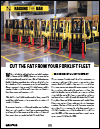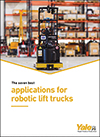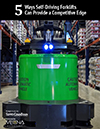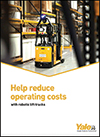Whitepapers
Lift Trucks / Forklifts
FILTER BY CATEGORY
- 3PL
- 4PL & LLP
- Automation
- Barcode & RFID
- Bulk
- Canada Logistics
- Chemical Logistics
- Cold Chain Logistics
- Customs Compliance & Duty Drawback
- Data Analytics
- Data Management
- Demand Planning & Forecasting
- Distribution Center Management
- Drayage
- E-Commerce
- Education
- Finance
- Fleet Management
- Food Logistics
- Freight Forwarding
- Freight Payment, Audit & Billing
- Fulfillment / eFulfillment
- Global Logistics
- Global Trade
- HazMat
- Intermodal
- Labor Management
- Last Mile / Final Mile
- Lift Trucks / Forklifts
- Logistics IT
- Materials Handling
- Moisture & Temperature Control
- Ocean
- Package Delivery
- Packaging
- Parcel
- Ports
- Printers & Labels
- Rail
- Real Estate
- Refrigerated Warehousing
- Retail
- Retail Logistics
- Reverse Logistics
- Risk Management
- Robotics
- Routing, Scheduling & Shipping Technology
- Security Solutions
- Site Selection
- Small Package Services
- Sourcing & Negotiations
- Supply Chain Execution
- Supply Chain Management & Optimization
- Supply Chain Mgmt/Optimization
- Sustainability
- TMS
- Transportation
- Transportation & Freight Management
- Trucking
- Trucking-LTL
- Trucking-TL
- Vendor Compliance
- Visibility
- Warehousing
- Wireless/Mobile Technology
- WMS
- Yard Management

Cut the Fat From Your Forklift Fleet
Optimizing your lift truck fleet according to business requirements can help protect slim margins and maximize productivity. This white paper examines the value of a fleet management program and how to evaluate it for ongoing success."

7 Best Applications for Robotic Lift Trucks
Robotic lift trucks are increasingly popular, but where do they fit in your operation? You need a solution to address challenges finding and retaining employees, and robotics are capable of handling a wide range of vertical storage and horizontal transportation tasks. The challenge is translating those capabilities to your operation. This whitepaper covers the seven best workflows for robotic lift trucks.

Five Ways Self-Driving Forklifts Provide a Competitive Edge
Explore how self-driving forklifts are creating more profitable operations and providing facilities a competitive edge. Labor force insecurity combined with a shifting and intensifying market demand has made the cost of delaying improvements too high. Facilities that advance their operations with driverless equipment reduce overhead costs while speeding up fulfillment, improving workflows, and extending the staff they already have. Learn how companies using this equipment are getting ahead.

Robotic Lift Trucks Can Cut Operating Expenses Up To 70%
Think the productivity increases associated with robotic lift trucks come at a steep price? Think again. Robotic lift trucks can actually help warehouses to reduce operating expenses by up to 70% and achieve meaningful savings over time. This whitepaper examines how robotic lift trucks can offer a scalable solution and a quick return on investment.

Lift Truck Sanitization Best Practices
From daily operation to service calls, personnel interact with lift trucks in several ways, all of which can risk virus transmission without proper sanitization. We’ve compiled a guide, drawing on guidance from the CDC and applying it to lift truck operation, including best practices for equipping personnel with the right supplies, sanitizing lift truck equipment, incorporating sanitization as part of daily routines and managing risk with vendor consolidation. Download now.

6 signs you need to re-evaluate your lift truck power
Power Challenges? Re-evaluate your lift truck power source. Read Yale Materials Handling – North America’s white paper to boost efficiency

The True Cost of Ownership for Counterbalance Forklifts: Understanding the Impact of Hidden Costs
Counterbalance forklift owners seeking to best manage their industrial equipment investment will find this new whitepaper very helpful. It explores how performance and durability, service and maintenance, and ergonomics can impact overall expenses; and illustrates how important it is to take a more comprehensive approach to understanding the true cost of ownership for counterbalance forklifts.

Changing Metrics – and Mindsets – in the Warehouse
Forklift connectivity provides the visibility to manage fleets for greater safety and productivity, and is a key building block of the connected warehouse of the future. This three-part whitepaper series captures the technology adoption best practices Crown’s team has observed and implemented in diverse materials handling applications. The purpose of the series is to help accelerate forklift fleet management adoption and prepare the industry for more complex technology initiatives.
